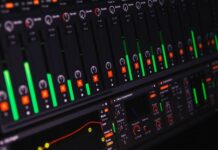Music is a universal language that can convey emotions and messages without the need for words. It is a combination of various elements such as melody, rhythm, harmony, and timbre. Timbre is one of the fundamental aspects of music that gives it a unique character and personality. In this article, we will delve deeper into the concept of timbre, how it affects music, and how it can be used to create different moods and emotions.
What is Timbre?
Timbre is the quality of sound that distinguishes one instrument or voice from another. It is what makes a violin sound different from a trumpet, or a soprano sound different from a tenor. Timbre can be described as the “color” of sound or the unique fingerprint of a sound source.
Timbre is determined by various factors such as the shape and size of the instrument, the material it is made of, and the way it is played or sung. For example, the timbre of a guitar played with a pick is different from the timbre of the same guitar played with fingers. Similarly, the timbre of a flute made of wood is different from the timbre of a flute made of metal.
Timbre vs. Tone
Many people confuse timbre with tone, but they are two different concepts. Tone refers to the pitch or frequency of a sound, whereas timbre refers to the quality of that sound. For example, a guitar and a piano can play the same note, but they will sound different because they have different timbres.
Timbre and Musical Instruments
Every musical instrument has a unique timbre that sets it apart from others. The timbre of an instrument is affected by its physical characteristics such as the size, shape, and material. For example, a cello has a warm, rich timbre because of its large size and the fact that it is made of wood. On the other hand, a trumpet has a bright, brassy timbre because of its small size and the fact that it is made of metal.
Timbre and Emotions
Timbre can be used to convey emotions and moods in music. For example, a sad or melancholic mood can be created by using instruments with a warm and mellow timbre such as a cello or a saxophone. In contrast, a joyful or uplifting mood can be created by using instruments with a bright and cheerful timbre such as a trumpet or a flute.
Timbre in Different Genres
Different genres of music use timbre in different ways. For example, classical music places a lot of emphasis on the timbre of instruments and how they blend together. Jazz music, on the other hand, uses timbre to create unique and improvisational sounds. Rock music often uses distorted guitar sounds to create a raw and powerful timbre.
The Role of Timbre in Music Production
In music production, timbre plays a crucial role in creating a balanced and cohesive sound. The producer needs to carefully choose the instruments and sounds that will be used in the song to create the desired timbre. The mixing and mastering process also involves manipulating timbre to make sure that all the elements of the song sound good together.
How to Manipulate Timbre
There are various ways to manipulate timbre in music production. One way is through equalization (EQ), which involves boosting or cutting certain frequencies to enhance or reduce certain aspects of the timbre. Another way is through the use of effects such as reverb or distortion, which can alter the texture and character of the sound.
Famous Examples of Timbre in Music
There are countless examples of timbre in music, but some of the most famous ones include:
- The warm and rich timbre of Louis Armstrong’s trumpet in “What a Wonderful World.”
- The bright and jangly timbre of The Beatles’ guitars in “A Hard Day’s Night.”
- The distorted and powerful timbre of Jimi Hendrix’s guitar in “Purple Haze.”
- The haunting and ethereal timbre of Enya’s vocals in “Orinoco Flow.”
Benefits of Understanding Timbre
Understanding timbre can enhance your appreciation and enjoyment of music. It can also help you create better music if you are a musician or producer. By understanding how different instruments and sounds contribute to the overall timbre of a song, you can make more informed decisions when creating your own music.
Conclusion
In conclusion, timbre is a crucial element of music that gives it its unique character and personality. It is the quality of sound that distinguishes one instrument or voice from another, and it can be used to convey emotions and moods in music. Understanding timbre can help you appreciate and create better music, and it is an essential concept for anyone interested in music theory.
FAQs
- What is the difference between timbre and tone?
Tone refers to the pitch or frequency of a sound, whereas timbre refers to the quality of that sound.
- Can timbre be manipulated in music production?
Yes, timbre can be manipulated through equalization, effects, and other techniques.
- How does timbre affect the mood of music?
Different timbres can create different moods in music. For example, a warm and mellow timbre can create a sad or melancholic mood, while a bright and cheerful timbre can create a joyful or uplifting mood.
- Why is timbre important in music production?
Timbre is important in music production because it helps create a balanced and cohesive sound. By choosing the right instruments and sounds with the desired timbre, producers can make sure that all the elements of the song sound good together.
- Can two instruments with the same pitch have different timbres?
Yes, two instruments with the same pitch can have different timbres because they have different physical characteristics that affect the quality of the sound.
Source: https://onlinevideograder.com/









